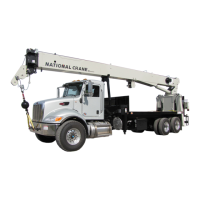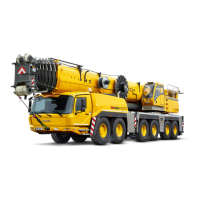Manitowoc Published 05-15-17, Control # 043-09 2-9
999 LUFFING JIB OPERATOR MANUAL SAFETY INFORMATION
hazards. The effectiveness of grounding is limited
by the size of the conductor (wire) used, condition
of the ground, the magnitude of voltage and current
present, and numerous other factors.
16. Wind can cause the crane to tip or the boom and other
attachments to collapse. The operator or qualified
person directing the lift shall compensate for the effect of
wind on the load and boom by reducing ratings, reducing
operating speeds, or a combination of both.
Unless otherwise specified in the Capacity Chart, or in
Operator Manual, stop operation under the following
wind conditions:
a. If the wind causes the load to swing forward past the
allowable operating radius or sideways past either
boom hinge pin, land the load and apply the drum
brakes.
b. If the wind exceeds 35 mph, land all loads and apply
the drum brakes, lower the boom onto blocking at
ground level or otherwise restrain it, and apply the
swing and travel brakes and/or locks.
NOTE: “Land load” means to set it down on a firm
uniformly supporting surface.
17. Booms, jibs, or masts which are being assembled or
disassembled on the ground (with or without support of
boom rigging) must be securely blocked to prevent the
boom, jib, or mast sections from dropping.
Workers shall not go under boom, jib, or mast
sections when removing connecting pins or bolts.
18. Each outrigger must be visible to the operator or the
signal person during extension and retraction.
Handling Load
Size of Load
1. The crane must not be loaded beyond the applicable
static or dynamic ratings given in the Capacity Chart for
the crane configuration.
NOTE: Capacity charts for Manitowoc cranes show the
total weight of freely suspended loads for various
boom and jib lengths and operating radii.
“Freely suspended load” is a load that is hanging
free with no direct external force applied except by
the crane’s load-line reeving.
To determine the actual weight of the load which
can be lifted at a given radius (working load), the
operator shall deduct the weight of certain lifting
equipment from the total weight given in the chart.
See the specific Capacity Chart for your crane for a
list of lifting equipment which must be deducted.
The operator’s judgment shall be used to further
reduce total the load to allow for the dynamic
effects of swinging, hoisting, or lowering, and
adverse weather conditions to include wind.
2. The operator or other designated person directing the lift
shall verify that the weight of load is within the static or
dynamic rating for radius at which load will be lifted.
Verified weights and measured radii must take
priority over RCI/RCL readings.
Attaching Load
1. Attach the hook to the load with slings, or other suitable
rigging. Each hook must have a latch that is in proper
working order. Hook latches must not be wired open.
a. Inspect each hook and latch before using.
b. Never use a hook or latch that is distorted or bent.
c. Make sure spring will force the latch against the tip
of the hook.
d. Make sure the hook supports the load. The latch
must never support the load. Latches are only
intended to retain loose slings under slack
conditions.
2. Only use slings and other rigging that are in safe
operating condition and have a rating equal to or greater
than the load to be lifted.
3. Do not wrap the load line around the load.
4. Use suitable protection between slings and any sharp
edges on the load. When synthetic slings are used, the
synthetic sling manufacturer's instructions, limitations,
specifications, and recommendations must be followed.
5. Secure unused legs of a multi-leg sling before handling
a load with one leg of sling.
Lifting/Moving Load
1. Before lifting or moving a load, the operator or qualified
person directing the lift shall make the following checks:
a. Crane has a firm, uniformly supporting foundation
under all crawlers. Unless otherwise specified in the
Capacity Chart, the foundation must be level to
within 1% — 1ft (0,3 m) rise or fall in 100 ft (30,5 m)
distance.
When such a surface is not available, it must be
provided with timbers, cribbing, or other structural
members to distribute the load such that the
allowable bearing capacity of the underlying
member is not exceeded.
For ground bearing data go to:
www.manitowoccranes.com

